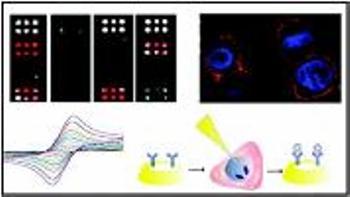A detailed review of the recent success in using nanoparticles to detect tumor cells and biomarkers based on electrochemical and optical techniques has been published in the journal, Chemical Society Review.
 Cancer detection using nanoparticle-based sensors
Cancer detection using nanoparticle-based sensors
The traditional tumor diagnostic techniques are increasingly being replaced with nanoparticle-based techniques. Besides the limitations associated with the sensitivity, the utilization of nanoparticle-based sensors in detecting tumor cell or biomarker has certain other benefits when compared to traditional methods.
A research team headed by ICREA Professor, Arben Merkoçi from the Catalan Institute of Nanotechnology (ICN ) in partnership with Maëlle Perfézou from Cranfield University, UK and Anthony Turner, a Professor from Cranfield University, UK and Linköping University have examined recent nanotechnology-based tumor diagnostics techniques, which are increasingly providing ideal substitutes to conventional methods.
It is very important to quantify cancer biomarkers concentration at extremely high sensitivity in serum, tissues, or blood. Perfect tests must enable the detection of numerous tumor biomarkers, even at single cell/biomolecule level, in a single test itself and must have minimum detection restrictions. The nanoparticle-based sensors used in cancer cell or biomarker detection offer several advantages. The methods are cost-effective and suitable for large-scale production technology. It requires a small amount of sample, allowing standard and elaborate testing. The nanoparticle-based methods and materials can be integrated easily into user-friendly equipment. Additionally, nanoparticles-based immunoassays are extremely sensitive and unique.
This enhances the biosensor‘s sensitivity and specificity. Nanoparticles-based biosensors are capable of attaching to tumor cells or biomarkers at the initial stage of tumor, even though the concentration of the cells is very low in the serum.